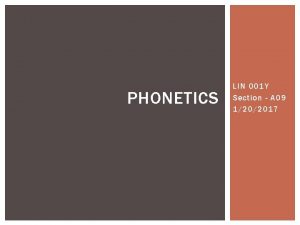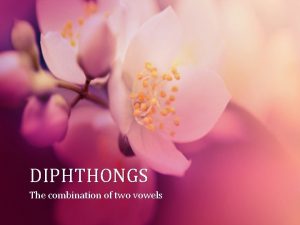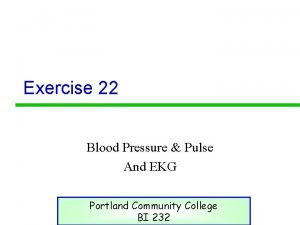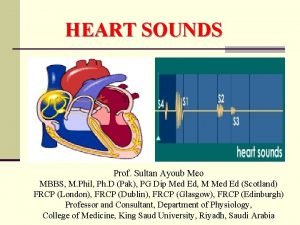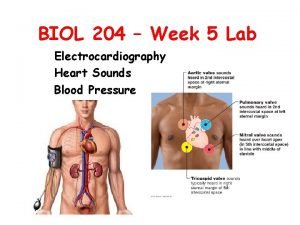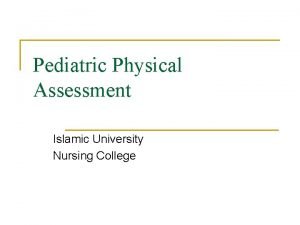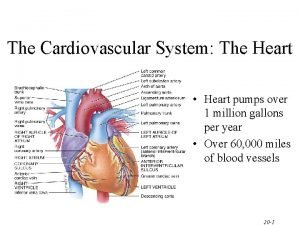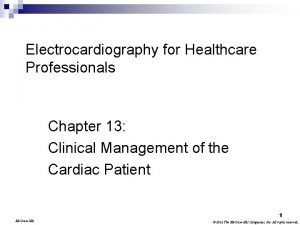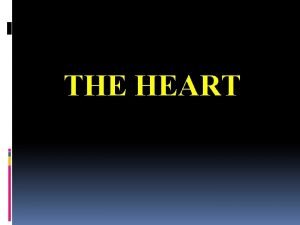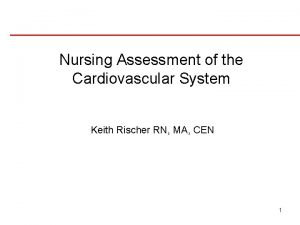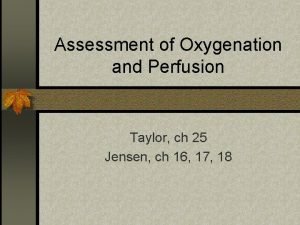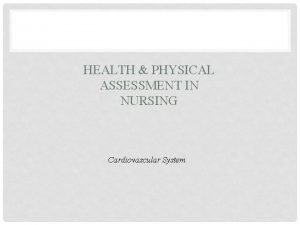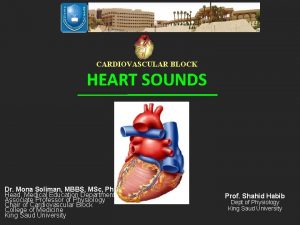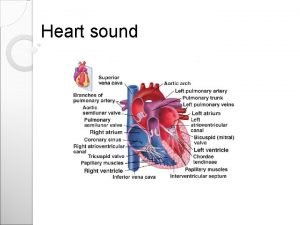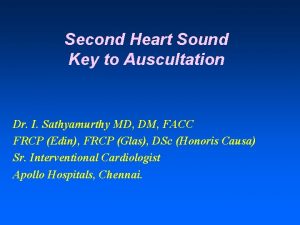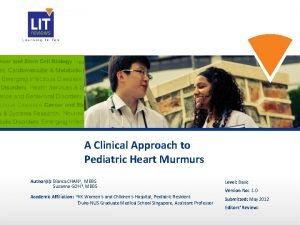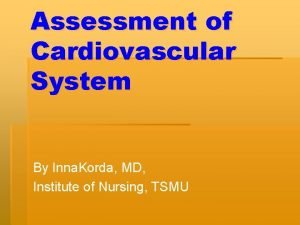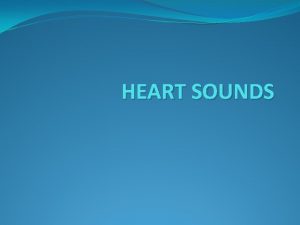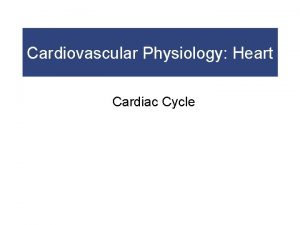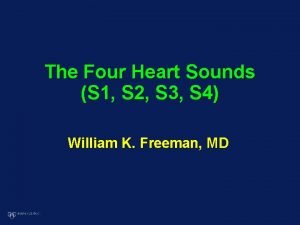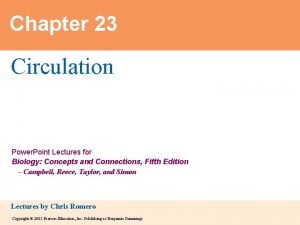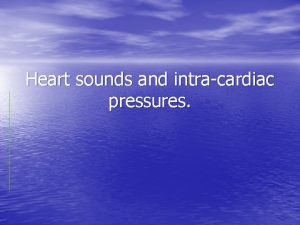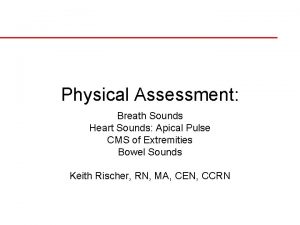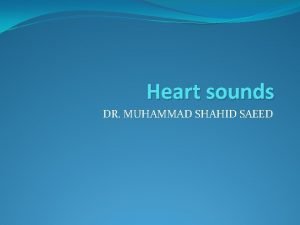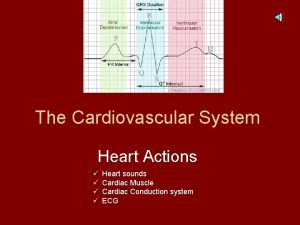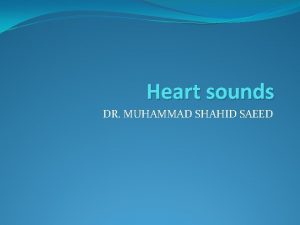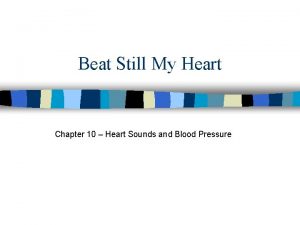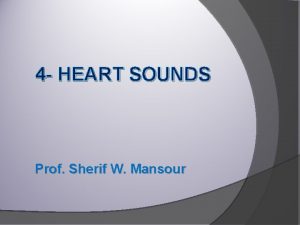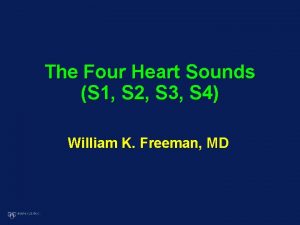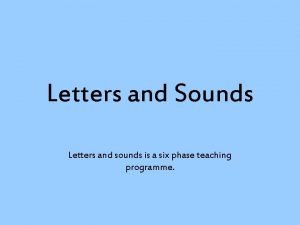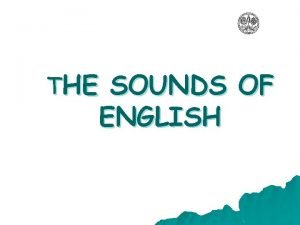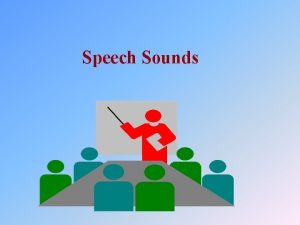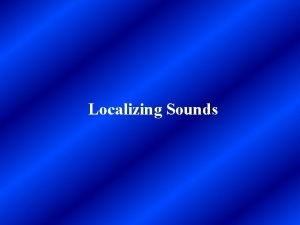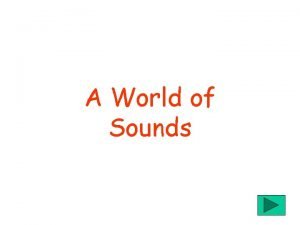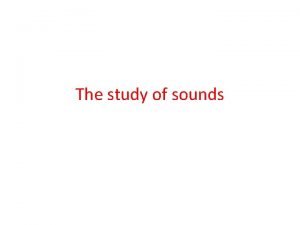The Four Heart Sounds S 1 S 2











































- Slides: 43

The Four Heart Sounds (S 1, S 2, S 3, S 4) William K. Freeman, MD

Learning Objectives • Understand the mechanisms and timing of the four heart sounds: S 1, S 2, S 3, and S 4 • Integrate auscultation, carotid upstroke, and jugular venous pulsation in the identification of the four heart sounds • Discuss common abnormalities of S 1 and S 2 • Understand the pathophysiology associated with S 3 and S 4 and the differential diagnosis of these findings

Pearls for the Cardiac Physical Exam • • • Use a quiet and private location Adjust bed for the patient’s comfort and yours Examine from the patient’s right Observe, palpate, then listen Assess venous and arterial pulsations Auscultation in sitting, supine, and left lateral decubitus positions Utilize all information available Develop your own protocol: be efficient and complete without missing details Don’t examine through clothing

Right and Left Ventricular Outflow Tracts Ao PA R L LVOT RV RVOT LV Anterior View King Tut

Cardiac Auscultation: Listening Positions AV PV L 2 nd ICS R 2 nd ICS TV L 5 th ICS MV

ECG Aorta PA LA LV RA RV MVC TVC AVC PVC S 1 S 2


The Normal Carotid Upstroke < 400 msec LV ejection MV closure (S 1) (including IVCT)

The First Heart Sound: S 1 Timing with the Carotid Upstroke • The predominant component of S 1 is MV closure • The carotid upstroke immediately follows S 1 in the absence of LV outflow obstruction • Simultaneous auscultation while palpating the carotid upstroke very useful in timing S 1 with irregular rhythm and variable S 1 intensity (AFib, frequent ectopy) or if S 1 is soft in intensity

S 2 louder than S 1 at the base S 1 is louder than S 2 at the apex

The First Heart Sound: S 1 Decreased Intensity Increased Intensity • Severe LV systolic • Hyperdynamic LV systolic • MV leaflet malcoaptation • MV leaflets are wide open dysfunction (↓↓ d. P/dt) or immobility • MV leaflets partially closed at onset of systole (prolonged A-V conduction or ↑↑ LVEDP) function (↑d. P/dt) at the onset of systole (short A-V conduction or mitral stenosis with pliable leaflets)

Which door will be loudest when forcefully swung closed? 1 2

Jugular Venous Pulsation Evaluation 3 cm (from sternum to JVP) + 5 cm (from RA to sternum) 8 cm H 2 O Jugular Venous Pressure QRS ECG 3 cm 5 cm T P a x Normal JVP wave form Heart tones a c v x S 1 S 2 y

Normal Jugular Venous Pulse Timing with S 1 and S 2

Cardiac Auscultation: Listening to S 2 AV PV L 2 nd ICS R 2 nd ICS TV L 5 th ICS MV

Components of S 2 are best heard over the pulmonic listening site

The Second Heart Sound: S 2 Increased Intensity • Systemic hypertension ( A 2 component) Decreased Intensity • Semilunar valvular stiffening / stenosis • Pulmonary hypertension • Semilunar valvular ( P 2 component) • Dilated ascending aorta ( A 2 component) • Dilated main pulmonary artery ( P 2 component) malcoaptation/regurgitation • Systemic hypotension ( A 2 component)

Physiologic Splitting of S 2 S 1 S 2 Expiration M 1 T 1 A 2 P 2 Inspiration M 1 T 1 A 2 Increased systemic venous return P 2 40 -60 msec

Paradoxic Splitting of S 2 S 1 Expiration Inspiration M 1 T 1 Increased systemic venous return S 2 P 2 A 2 Delayed AV Closure (after P 2)

Paradoxic Splitting of S 2 Common Causes • Left bundle branch block (LBBB) conduction delays LV depolarization and ejection • Right ventricular pacemaker causes LBBB conduction • Left ventricular outflow obstruction (AS, HOCM) delays LV ejection • Severe LV systolic dysfunction prolonged LV ejection

The Third Heart Sound: S 3 • Low frequency, passive filling sound occurring during the early rapid ventricular filling phase of diastole • Likely generated from reverberations due to sudden impact of blood against the myocardium as diastolic ventricular expansion suddenly decelerates • Left-sided S 3: heard best at the apex Right-sided S 3: heard best at tricuspid site

The Third Heart Sound: S 3 Etiologies • Any condition associated with increased ventricular filling pressure; widely variable degree of ventricular systolic dysfunction and dilatation • Increased ventricular filling volume: severe mitral regurgitation (LV S 3) or tricuspid regurgitation (RV S 3) • A combination of both of the above • High cardiac output states; large left-to-right shunts • “Juvenile” S 3 (healthy patients < 30 yrs old) with vigorous early diastolic LV relaxation

The Third Heart Sound: S 3 Associated LV/LA Hemodynamics Young/Healthy Normal Heart Failure LA Pressure Normal LA Pressure a LA LV x v y LV Pressure S 1 S 2 S 3 Vigorous early LV relaxation causes suction of blood from LA S 3 Blood pushed into the LV under high LA filling pressure; LV diastolic pressure

Cardiac Auscultation: Listening to S 3 AV PV L 2 nd ICS R 2 nd ICS TV MV L 5 th ICS RV S 3 LV S 3

Point of Maximal Impulse (PMI)

Left Lateral Decubitus Position

Stethoscope: Bell vs. Diaphragm Bell Use minimal pressure when applied to chest (Low frequency) Diaphragm Use firm pressure when applied to chest (High frequency)

Low and High Frequency Sounds Explained Listening with the Stethoscope Low frequency = Bell High frequency = Diaphragm

Turning the Bell Into a Diaphragm Bell Use minimal pressure when applied to chest (Low frequency) Press down Diaphragm Pressing Down on the Bell Creates a diaphragm at the skin interface (Eliminates low frequency range)

“Pressing Out” an S 3 Gallop Bell S 1 S 2 S 3 Bell Press down Press Down S 1 S 2 Diaphragm Release S 3 S 1 S 2 Bell


Pressing Out an S 3 or S 4 Gallop Things That Don’t Disappear with Pressing the Bell • Split S 1 (mistaken for an S 4) • Split S 2 (mistaken for an S 3) • Systolic ejection clicks • Opening snap

The Third Heart Sound: S 3 MV opens MV closes LA a c v x y LV S 1 S 2 S 3

The Third Heart Sound: S 3 Cadence S 3 S 1 S 2 Ken tuck y

The Fourth Heart Sound: S 4 • Low frequency, end-diastolic active filling sound due to forceful atrial contraction injecting blood into a ventricle with limited compliance ( V/ P) • Likely generated from reverberations due to sudden impact of blood against the myocardium as end-diastolic ventricular expansion suddenly decelerates • Must have atrial contraction to generate an S 4; NOT possible with atrial fibrillation • Left-sided S 4: heard best at the apex -sided S 4: heard best at tricuspid site Right

The Fourth Heart Sound: S 4 Etiologies An S 4 may be present in any condition which decreases ventricular filling compliance ( V/ P) • Ventricular hypertrophy • Myocardial fibrosis • Myocardial ischemia / infarction • Myocardial infiltration

Cardiac Auscultation: Listening to S 4 AV PV L 2 nd ICS R 2 nd ICS TV MV L 5 th ICS RV S 4 LV S 4

The Fourth Heart Sound: S 4 Elevated end-diastolic LA and LV pressures MV closes a x MV opens v y LA LV S 1 S 4 S 2

The Third Heart Sound: S 4 Cadence S 4 S 1 Ten nes S 2 see

“Pressing Out” an S 4 Gallop Bell S 4 S 1 S 2 Bell Press down Press Down S 1 S 2 Diaphragm Release S 4 S 1 S 2 Bell


Summation Gallop: S 4 and S 3 Cadence S 4 S 1 Al a S 2 S 3 bam a

The Four Heart Sounds (S 1, S 2, S 3, S 4) Conclusions • The first (S 1) and second (S 2) heart sounds are the foundation of the cardiac physical exam and must be timed and characterized correctly • Corroborate S 1 and S 2 timing with the carotid and jugular venous exams • Careful listening with the bell, including the press-out maneuver, allows accurate detection of the S 3 and S 4 gallop • Detection of S 3 and S 4 heart sounds provide important clues to underlying cardiac pathophysiology
 Oral sounds and nasal sounds
Oral sounds and nasal sounds Combination of two vowel sounds
Combination of two vowel sounds Auscultation of heart sounds
Auscultation of heart sounds Mitral regurgitation murmur
Mitral regurgitation murmur Heart sounds
Heart sounds Sucking reflex disappear
Sucking reflex disappear Heart sounds on chest
Heart sounds on chest What are the 5 heart sounds
What are the 5 heart sounds Heart sounds location
Heart sounds location Apetm heart sounds
Apetm heart sounds Apetm heart sounds
Apetm heart sounds Normal sinus rhythm
Normal sinus rhythm Apical pulse auscultation location
Apical pulse auscultation location Dr mona soliman
Dr mona soliman What causes s4 sound
What causes s4 sound Pulmonic component of second heart sound
Pulmonic component of second heart sound Neonatal heart auscultation
Neonatal heart auscultation Heart sounds location
Heart sounds location Splitting heart sounds
Splitting heart sounds Heart sounds and murmurs
Heart sounds and murmurs Pericardial friction
Pericardial friction Which is the best area for auscultating the apical pulse
Which is the best area for auscultating the apical pulse Heart sound auscultation areas
Heart sound auscultation areas Sheep heart labeled
Sheep heart labeled Stars dogs plowhorses and puzzles
Stars dogs plowhorses and puzzles Heart border percussion of heart
Heart border percussion of heart Four chamber heart
Four chamber heart Quá trình desamine hóa có thể tạo ra
Quá trình desamine hóa có thể tạo ra Vẽ hình chiếu vuông góc của vật thể sau
Vẽ hình chiếu vuông góc của vật thể sau Công thức tiính động năng
Công thức tiính động năng Tỉ lệ cơ thể trẻ em
Tỉ lệ cơ thể trẻ em Thế nào là mạng điện lắp đặt kiểu nổi
Thế nào là mạng điện lắp đặt kiểu nổi Hình ảnh bộ gõ cơ thể búng tay
Hình ảnh bộ gõ cơ thể búng tay Lời thề hippocrates
Lời thề hippocrates Các loại đột biến cấu trúc nhiễm sắc thể
Các loại đột biến cấu trúc nhiễm sắc thể Vẽ hình chiếu đứng bằng cạnh của vật thể
Vẽ hình chiếu đứng bằng cạnh của vật thể độ dài liên kết
độ dài liên kết Môn thể thao bắt đầu bằng từ chạy
Môn thể thao bắt đầu bằng từ chạy Sự nuôi và dạy con của hổ
Sự nuôi và dạy con của hổ điện thế nghỉ
điện thế nghỉ Nguyên nhân của sự mỏi cơ sinh 8
Nguyên nhân của sự mỏi cơ sinh 8 Trời xanh đây là của chúng ta thể thơ
Trời xanh đây là của chúng ta thể thơ Chó sói
Chó sói Slidetodoc
Slidetodoc
